Physical Address
304 North Cardinal St.
Dorchester Center, MA 02124
Ankle arthritis is a physically disabling condition, and its treatment can be both challenging and rewarding for the patient and the treating physician. Gait derangement is common in patients with ankle arthritis, and associated pain in the knee, hip, or back often contributes to general health problems. Arthrodesis, although not always perfect in outcome, can obtain a stable, pain-free ankle and dramatic improvement in the function and quality of life in appropriately selected patients. While the incidence of total ankle replacement is increasing, arthrodesis remains the procedure of choice for many patients with symptomatic ankle arthritis.
The biomechanical aspects of the ankle make it particularly suitable for arthrodesis. It is primarily a hinge joint and, although there is a continuously changing axis of rotation throughout the range of motion of the tibiotalar joint, fixation in a neutral position does not produce severe biomechanical consequences in the limb. The talus sits within a well-defined, stable architecture of the ankle mortise. It is supported by the medial malleolus, the congruent tibial plafond, and the lateral malleolus, all of which provide potential bone surfaces for healing of the arthrodesis. Since normal gait requires only 10 to 12 degrees of ankle extension and 20 degrees of ankle flexion, loss of some motion is not critical. This is in contrast to the knee or hip, where even modest loss of motion may be disabling for activities of daily living. Sagittal plane motion required for normal gait may be compensated for internally by a mobile transverse tarsal joint or externally by the application of a rocker sole shoe in a patient with ankle arthrodesis.
Surgical management of ankle arthritis is invasive, the recovery difficult, and the complications frequent. It is often best to think of the strategy in dealing with arthritis of the ankle as a management problem. It should be clear to the patient that returning the ankle to its prearthritic state is not possible, and conservative management may alleviate pain and restore function with little inherent risk. Conservative management will not improve pain and function to an acceptable level in all patients, but we routinely begin with several modalities before surgical intervention. This provides a measure of pain relief while giving the patient time to make intelligent, well-informed decisions regarding more invasive procedures .
Bracing to limit motion of the arthritic joint is a mainstay of conservative treatment. In our experience, the most effective brace is a double-upright, locked ankle brace with a steel shank and rocker sole in patients who are willing to accept the weight of the brace and shoewear limitations that accompany its use. It is durable and typically gives significant improvement in pain. It can accommodate deformity and changes in leg circumference from fluid shifts that may occur in this patient population. In other patients, an Arizona type brace, solid polypropylene ankle-foot orthosis, or lace-up ankle brace may be successful.
Nonsteroidal antiinflammatory agents are not without risks but may provide a measure of relief. Although glucosamine, chondroitin sulfate, and other dietary supplements are often tried, their efficacy is questionable. Intraarticular injections are a frequently used modality in these patients and, although hydrocortisone and a local anesthetic are a common combination, there may be a deleterious effect on viable cartilage and chondrocytes. Routine use of this modality outside of end-stage ankle arthritis is not recommended. Steroid injections are best used to aid in diagnosis and to temporarily alleviate pain in patients who are poor surgical candidates or who wish to delay elective surgical intervention until a time that better suits their schedule. The use of intraarticular hyaluronate preparations for viscosupplementation has been studied extensively in the knee. In the ankle, conflicting results have been found in well-designed studies. Sun et al. reported that in their 46 patients, three weekly intraarticular injections of hyaluronate provided pain relief and improved function, whereas DeGroot et al., in a randomized, double-blind, placebo-controlled study, found that a single intraarticular injection of hyaluronic acid was not demonstrably superior to a single intraarticular injection of saline solution for the treatment of osteoarthritis of the ankle. More recent studies have confirmed that multiple injections of hyaluronic acid are more effective than single-injection protocols and that the use of fluoroscopy is indicated to ensure intraarticular infusion. In their prospective study, Lucas et al. found that neither etiology nor severity of the osteoarthritis was predictive of the response to viscosupplementation; however, Han et al. identified early stage disease and pain duration of less than 1 year as independent predictors of good outcomes. Viscosupplementation in the ankle is an off-label use, and insurance coverage issues should be discussed with the patient before proceeding with this treatment.
Although arthrodesis is a mainstay of treatment for ankle arthritis, it is not an optimal treatment for all patients due to the loss of joint motion and possible development of degenerative adjacent joint arthritis. Operative alternatives to ankle arthrodesis include open or arthroscopic debridement, realignment osteotomies, distraction arthroplasty, allograft replacement, and total ankle arthroplasty. Before ankle arthrodesis is chosen by a patient, alternative procedures should be considered and discussed.
Arthroscopic or open debridement of the arthritic ankle can be effective in the overall management plan, but it must be used judiciously and with realistic expectations of the outcome ( Fig. 11.1 ). Efficacy has been shown in several studies for the removal of anterior impingement osteophytes from the tibia and/or talus. Patients with mechanical locking of the ankle from a demonstrable loose body may also benefit from arthroscopic management, but it is likely that the debridement of more advanced arthritic ankles provides only short-term relief and is not recommended in most cases. Increased motion following removal of impinging osteophytes in a joint with irregular arthritic surfaces may lead to different or increased pain postoperatively and should be discussed with the patient before surgery. Aggressive removal of osteophytes also may lead to anterior extrusion of the talus postoperatively. Arthroscopic or open debridement can be done in combination with other procedures such as osteotomy and distraction arthroplasty.
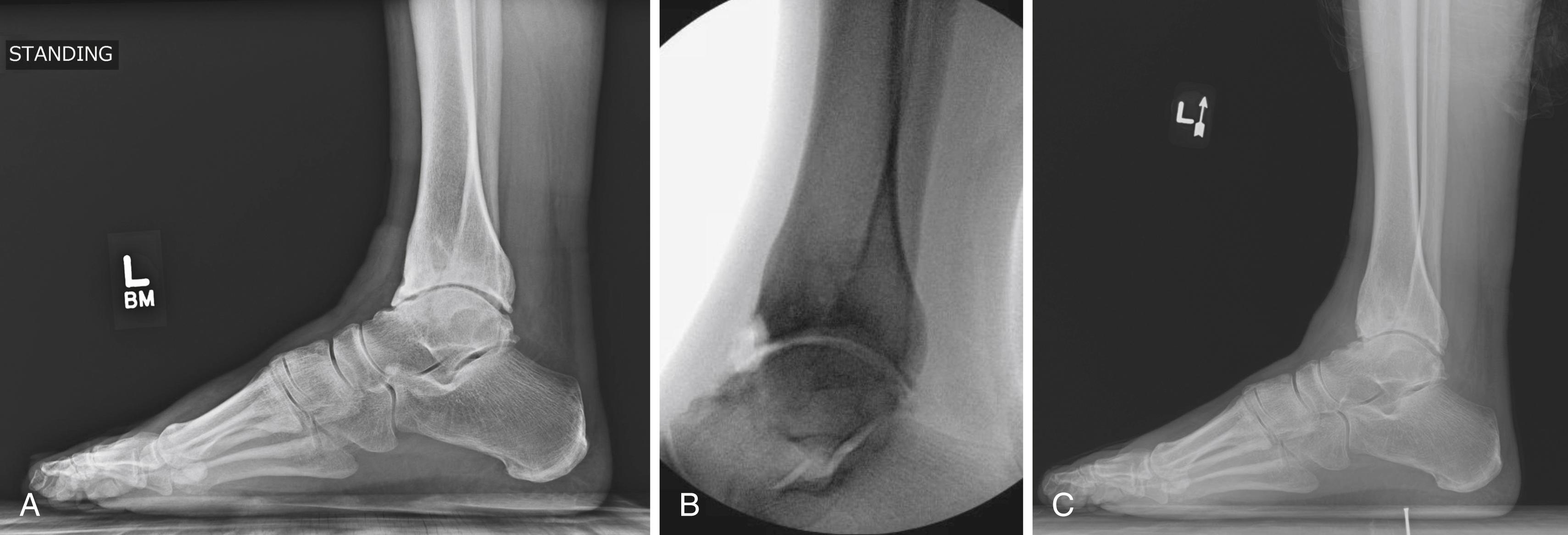
Periarticular osteotomies of the tibia, fibula, or hindfoot, alone or in combination, are reasonable approaches to the management of localized arthritis of the ankle. The goal of realignment osteotomies is to unload the more arthritic portion of the joint and provide a more anatomic mechanical axis to the ankle to redistribute joint contact forces and loads. Realignment surgery can delay the need for arthrodesis or arthroplasty in younger active patients. Chondral loss primarily in the medial or lateral gutter of the ankle with minimal involvement of the superior surface of the talus, especially with supramalleolar deformity, seems best suited for this approach. The type of osteotomy is determined by the specific deformity, the condition of the surrounding soft tissues, the status of the articular surface, and leg-length considerations. Opening wedge osteotomy of the tibia for varus deformity and medial joint arthrosis is particularly effective as an alternative to more invasive treatment. Ahn et al. reported improvements in American Orthopaedic Foot and Ankle Society (AOFAS) scores, visual analogue scale (VAS) scores, and medial-distal tibial angle in 18 patients with medial ankle osteoarthritis and mortise widening after opening wedge distal osteotomy without fibular osteotomy. Although talar tilt was not corrected by this procedure, excellent clinical results were obtained in ankles with more than 7 degrees of talar tilt and good results in an ankle with 11 degrees of tilt. Before surgery, correction is planned by measuring the tibial-ankle surface angle and talar tilt on a weight-bearing anteroposterior radiograph and the tibial-lateral surface angle on a lateral weight-bearing radiograph ( Fig. 11.2 ).
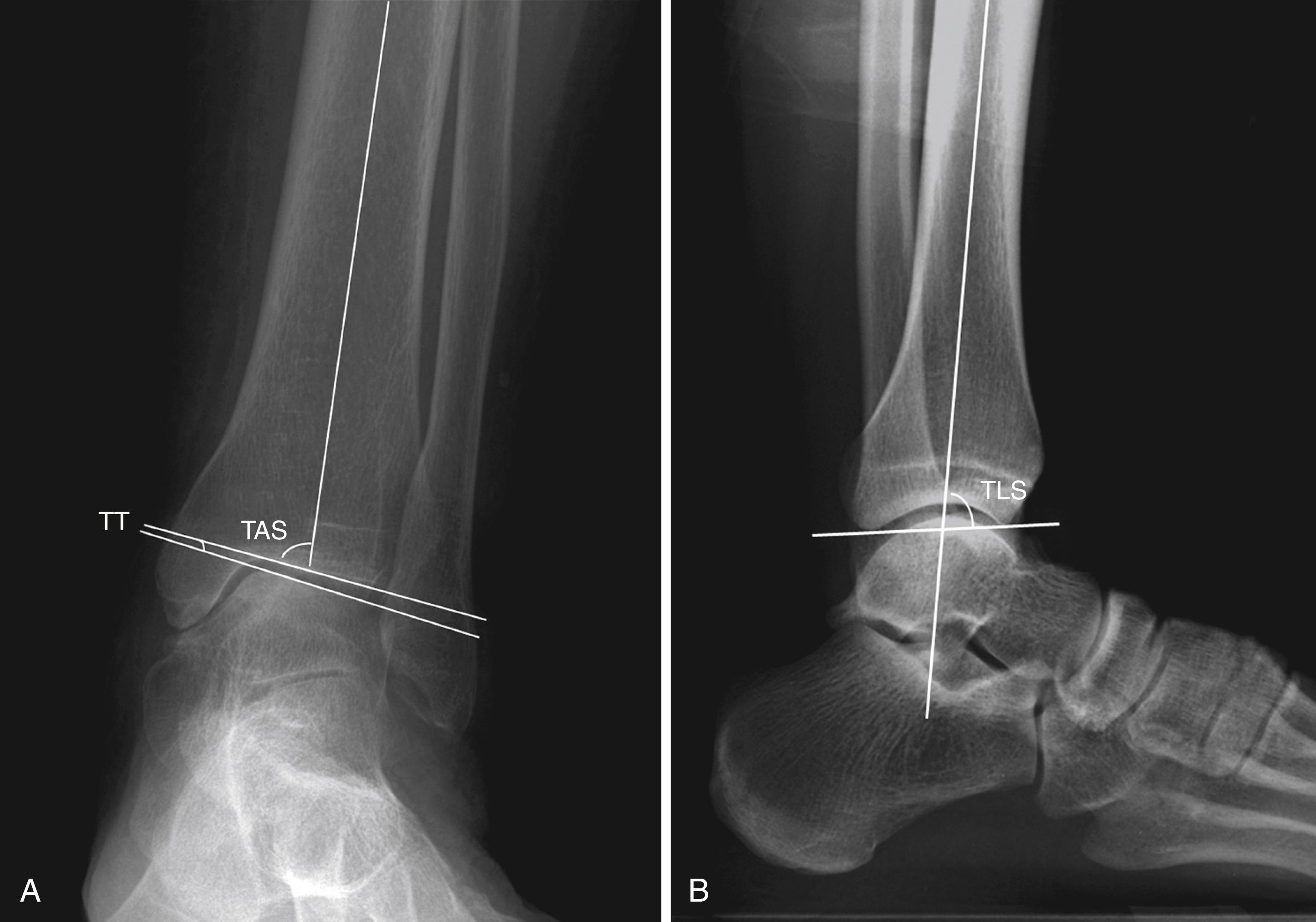
Through standard anteromedial and anterolateral portals, perform a full arthroscopic examination of the ankle. Debride any impinging osteophytes, delaminated cartilage, and joint fibrosis.
For the fibular osteotomy, make a 2-cm lateral longitudinal incision 3 to 4 cm proximal to the articular surface of the medial malleolus.
Use a sagittal saw to make an oblique fibular osteotomy, placing a transfixing screw from anterior to posterior before completion of the osteotomy; do not tighten the screw.
For the tibial osteotomy, make a longitudinal incision beginning proximal to the tip of the medial malleolus to expose the anterior surface of the distal tibia; retain as much of the periosteum as possible.
Mark the osteotomy based on preoperative templating with a Kirschner wire and make the osteotomy with a water-cooled bone saw. Do not completely transect the tibia but leave several areas of cortex on the lateral side.
Carefully open the osteotomy with a Hintermann distractor or lamina spreader. Confirm on imaging that the deformity has been satisfactorily corrected and that the necessary size of autograft matches the preoperative templating. Insert the previously harvested iliac crest autograft.
Apply a contoured plate over the medial tibia to secure the autograft in place ( Fig. 11.3 ).
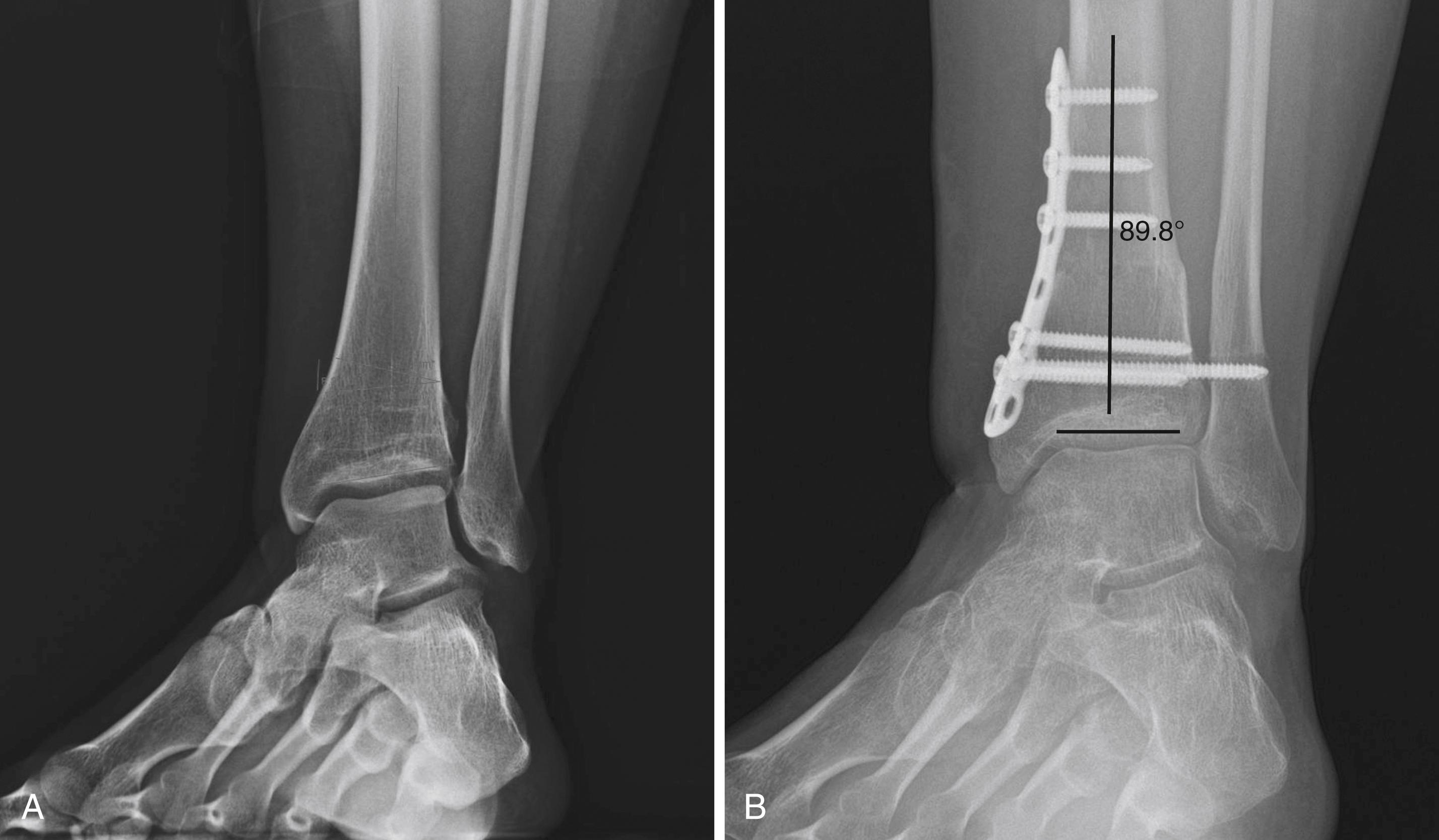
Confirm alignment by observation and anteroposterior and lateral fluoroscopy.
Contour a plate and apply it across the fibular osteotomy.
Irrigate the wounds and close the fascial layer, subcutaneous tissue, and skin. Apply a sterile dressing and a short-leg splint.
Non–weight-bearing ambulation is allowed the day after surgery, and flexion and extension exercises of the toes and knee are begun to prevent deep vein thrombosis and muscle weakness. A cast is worn for 4 to 6 weeks. After the cast is removed, active range-of-motion exercises of the ankle are begun. Weight bearing is gradually increased at 4 to 6 weeks in a fracture boot until full weight bearing out of the boot is allowed at 2 months after surgery.
Failure of traditional medial opening wedge and lateral closing osteotomy can occur because of persistence of the medial intraarticular tibial defect, resulting in recurrent varus deformity. Becker and Myerson described a technique specifically for juxtaarticular varus ankle deformity associated with osteoarthritis and ankle instability. Mann et al. reported good results with this technique, along with lateral ligament reconstruction, in 19 patients. Four patients required ankle arthrodesis or ankle arthroplasty 7 to 48 months after the procedure; the other 15 patients were satisfied with their outcomes.
(MANN, FILIPPI, AND MYERSON)
After administration of general anesthesia and popliteal block for postoperative pain control, approach the ankle through a medial incision centered at the level of the deformity.
Direct the apex of the osteotomy toward the intraarticular deformity from the medial aspect of the distal tibia.
Use a Kirschner wire aimed at the apex of the deformity as a guide to the plane of the osteotomy ( Fig. 11.4A ).
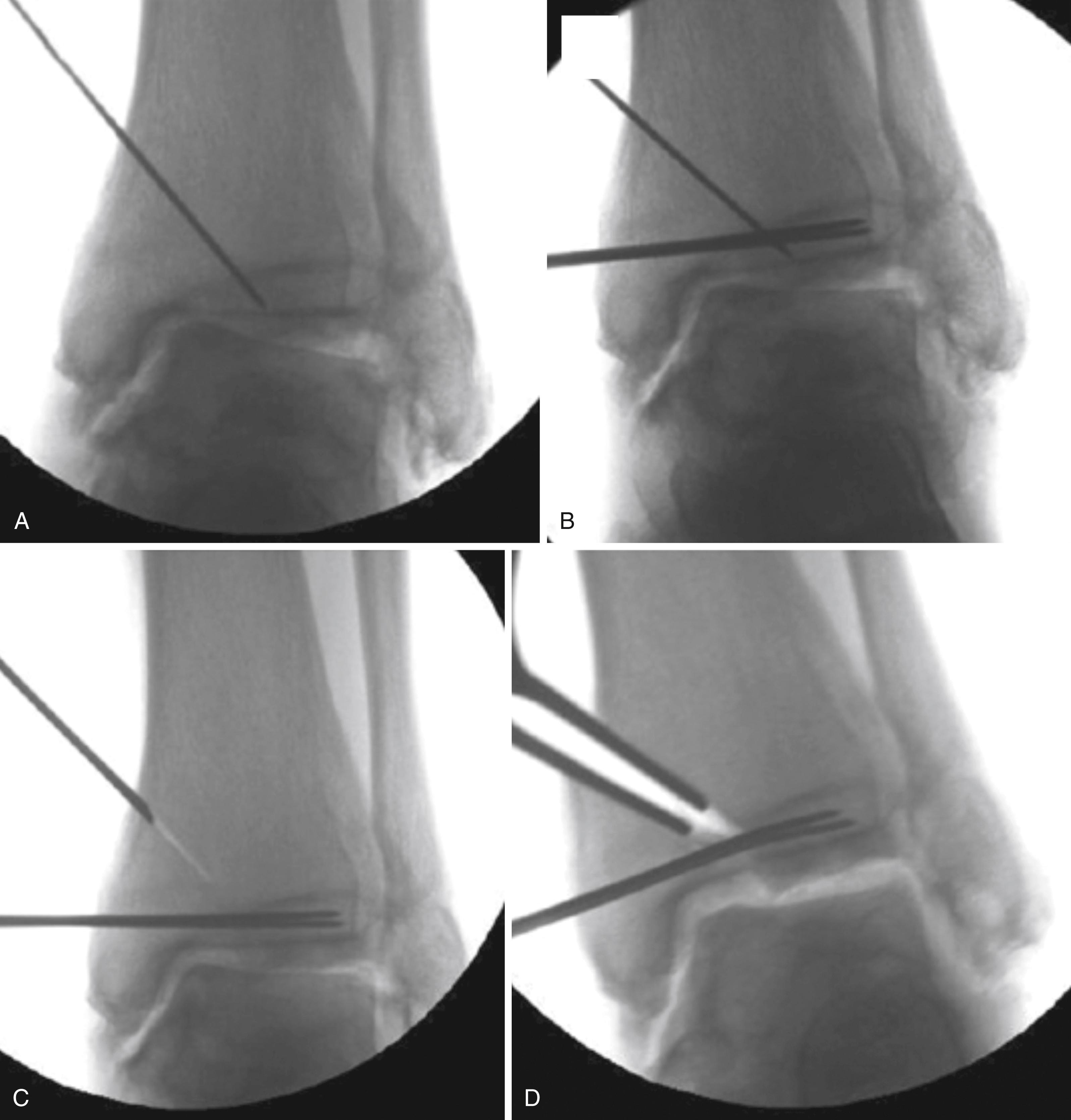
Insert three additional Kirschner wires parallel to the joint surface portion of the tibial plafond within the subchondral bone just under the articular cartilage at the apex of the plafond angulation to prevent penetration of the saw blade into the joint during the osteotomy and to act as a hinge during deformity correction ( Fig. 11.4B ).
Make the osteotomy with a saw perpendicular to the anteroposterior axis of the tibia and in the same plane as the Kirschner wire, ending at the level of the three Kirschner wires, thereby keeping the bony bridge intact ( Fig. 11.4C ).
Use the bony bridge and the three Kirschner wires as a hinge, and with a wide osteotome gradually bend the plafond until the medial tibial articular surface is parallel to the intact portion of the distal lateral tibia.
Insert a lamina spreader into the cortical gap to hold the correction while allograft cancellous bone chips are inserted into the defect under fluoroscopic guidance to maintain a parallel joint surface ( Fig. 11.4D ).
Secure the osteotomy with a locking plate to serve as a buttress to ensure that the allograft remains in place.
If lateral ankle instability is present, correct it with a Broström or modified Chrisman-Snook procedure (see Chapter 90 ) after ensuring that bone, osteophytes, and debris are removed from the lateral gutter.
Patients are placed in a below-knee splint for the first 2 weeks, followed by application of a removable boot with instructions to remain non–weight bearing but to perform range-of-motion exercises. At 6 weeks, partial weight bearing is allowed, and at 8 weeks, full weight bearing is permitted. The boot is worn for a total of 10 to 12 weeks, depending on healing of the osteotomy.
With technical improvements to thin-wire external fixation for various deformity correction procedures, reports of using a thin-wire frame to provide distraction to the ankle joint for a period of time while allowing weight bearing seem to suggest some pain relief and functional improvement in carefully selected patients with ankle arthritis. Joint distraction arthroplasty is based on the concept that mechanical unloading of the joint and the intermittent flow of intraarticular synovial fluid encourage cartilage healing. Twenty-one (98%) of 23 patients reported by Tellisi et al. reported decreased pain after distraction arthroplasty; other series have reported good results in approximately 75%. In a randomized controlled trial, Saltzman et al. compared fixed distraction to motion distraction in 36 patients and found that those with motion distraction had earlier and consistently better outcomes. Adverse events included 43 pin-track infections and eight neurapraxias.
The beneficial effects of distraction are not immediate and tend to occur over a long period of time, ranging from 6 months to 2 years. The ideal candidate for distraction arthroplasty is a young motivated patient whose symptoms are not relieved with conservative measures and who is unwilling to have an arthrodesis. Contraindications include active infection, advanced coronal plane deformity, significant loss of bone stock, and patients who are poor frame candidates . Uncontrolled diabetes, tobacco use, chronic edema of the lower limb, severe ankle deformity, and severe ankle ankylosis are relative contraindications. In a randomized study, Herrera-Perez et al. showed similar functional outcomes and quality of life with debridement and a hinged distraction compared to debridement alone, although the rate of postoperative revision surgery was higher if distraction was not used. According to a comprehensive review of the literature by Smith et al., currently there is not enough high-level evidence to support ankle joint distraction for generally accepted indications. Tellisi et al. noted some key elements of the procedure and postoperative care that may improve outcomes:
Hinges should be placed along the axis of the ankle joint (Inman axis, line joining tips of the medial and lateral malleoli) to prevent uneven joint distraction through a range of motion and to preserve joint motion by evenly stretching the capsule.
Use of a forefoot wire should be avoided because this is very uncomfortable and discourages weight bearing.
No more than 5 to 6 mm of acute distraction should be applied in the operating room; if needed, more distraction can be applied gradually during the short postoperative hospital stay.
Range-of-motion exercises should be started early to preserve ankle mobility.
A circular fixator is superior to monolateral fixation because a monolateral frame delivers uneven distraction through cantilever mechanics and its simple hinge is difficult to place along the ankle axis.
On weight-bearing radiographs, measure the tibiotalar joint space and evaluate the degree of arthritis ( Fig. 11.5A,B ).
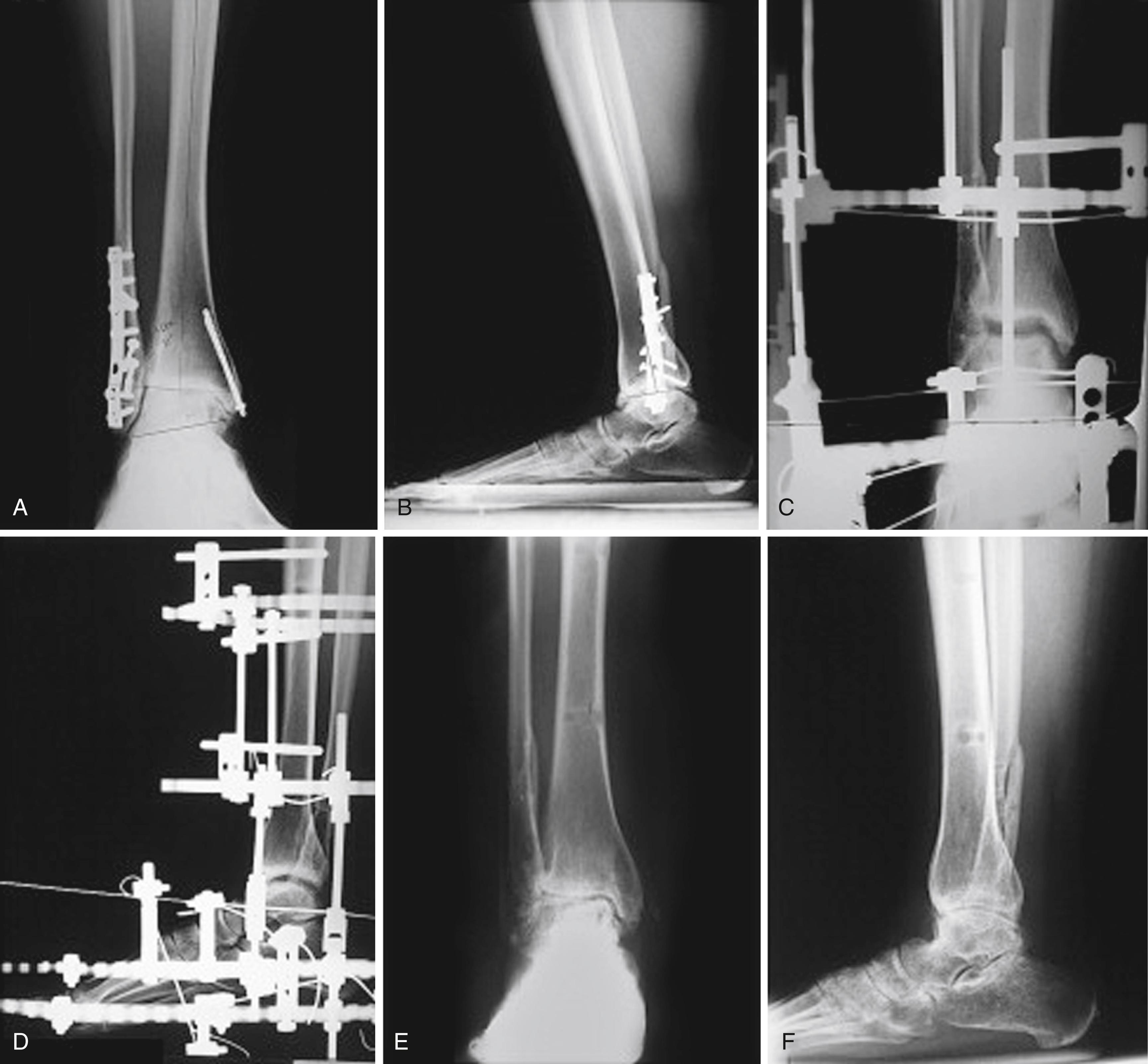
Identify anterior osteophytes that might be sources of pain or blocks to dorsiflexion and need to be removed.
Note the presence of any hardware in the ankle joint. Hardware generally does not need to be removed before distraction arthroplasty unless it inhibits application of the external fixator.
Evaluate the ankle for periarticular deformity and determine if supramalleolar osteotomy is indicated in place of or in conjunction with distraction arthroplasty.
With arthroscopy or open arthrotomy, remove anterior osteophytes from the distal tibia and talus.
Perform Achilles tendon lengthening or supramalleolar osteotomy as needed.
A tourniquet is not used during frame application because normal osseous and periosteal blood flow is needed to help cool passing wires and drills to avoid thermal necrosis.
Usually a two-ring fixator is sufficient, comprising a distal tibial ring and a foot ring, with articulating hinges placed along the ankle joint axis between the rings. An additional ring may be needed if supramalleolar osteotomy was done or to enhance the stability of the construct in larger patients.
Mount the proximal ring to the distal tibia with a combination of half-pins and tensioned wires. Place fixation in different planes to ensure adequate stability.
Use of hydroxyapatite-coated pins is encouraged because of the enhanced bone ongrowth and stability for the extended duration that the frame will be used.
Insert a smooth Kirschner wire immediately beneath the tip of the medial malleolus and check its position with anteroposterior and lateral fluoroscopy images to ensure proper placement ( Fig. 11.6A ).
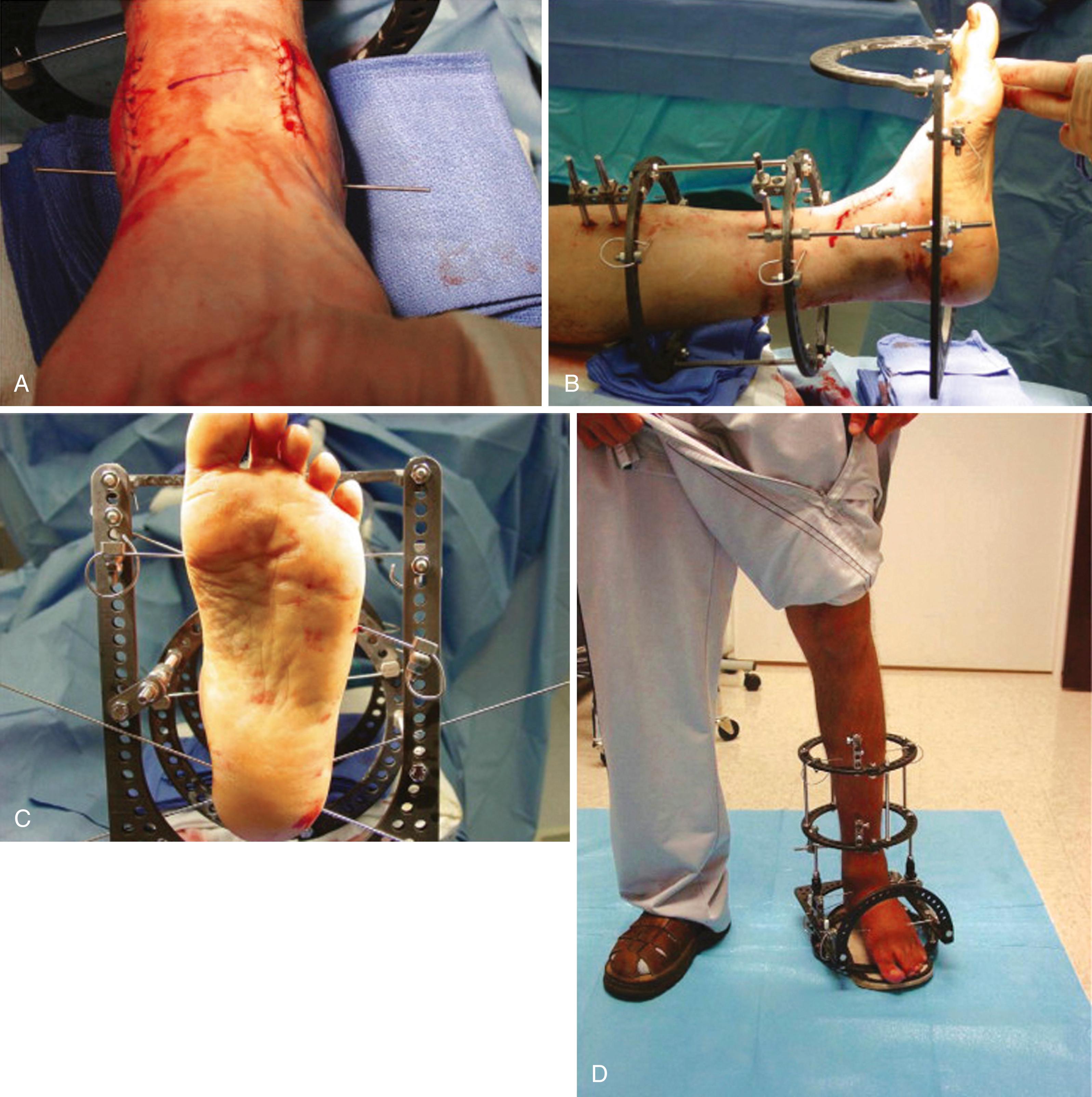
Attach two universal hinges with threaded rods, one on either side of the tibial ring. Place the hinges along the reference wire to approximate the true axis of rotation of the ankle joint. Check hinge placement with fluoroscopy.
Secure the hinges to a foot ring that has been aligned to the foot ( Fig. 11.6B ). Insert a transverse midfoot wire through the cuneiform bones and tension it to the ring to establish alignment. Place two additional wires into the calcaneus and tension them ( Fig. 11.6C ). Insert a final wire into the talus, attach it to the foot ring, and gently tension it; this wire prevents inadvertent distraction of the subtalar joint.
Place an anterior flexion-extension rod to control ankle motion.
Distract the ankle approximately 5 mm ( Fig. 11.5C,D ) and, under fluoroscopic control, move it through a range of motion to check the amount of distraction and alignment.
Place sterile dressings on the pin insertion sites.
Patients usually are observed in the hospital overnight after surgery for pain control. Partial weight bearing is begun as soon as tolerated after surgery with ambulatory aids as needed ( Fig. 11.6D ). Deep venous thrombosis prophylaxis is implemented and continued until the patient is mobile. The patient is instructed in pin care, which consists of showering daily and cleaning any inflamed pin sites daily with diluted hydrogen peroxide or chlorhexidine gluconate. At 2 weeks, the sutures are removed, and distraction is evaluated. The goal at this time is 5 mm of distraction; if the joint space is less, additional distraction is applied in the office. At 12 weeks, the frame is removed in surgery with the patient sedated, a cam walker boot is applied, and weight-bearing ambulation is encouraged ( Fig. 11.5E,F ). In their recent review, Bernstein et al. suggested the addition of bone marrow aspirate to the ankle at the time of frame application, no more than 3 mm of acute distraction at time of surgery with additional distraction added later to maintain at least 5 mm, and no more than 12 weeks of distraction .
A study looking at the Nationwide Inpatient Sample database from 2007 to 2013 showed the share of ankle replacement performed compared to arthrodesis increased markedly from 2007 (14%) to 2013 (45%), with arthrodesis patients continuing to have more comorbidities. The advantages and disadvantages of total ankle arthroplasty are discussed in detail in Chapter 10 . In general, arthrodesis has the advantage of predictable pain relief and the disadvantage of limited motion, whereas arthroplasty has the advantage of motion preservation and the disadvantage of more frequent complications. A study involving 114 ankle arthroplasties and 47 ankle arthrodeses reported no significant difference in the mean improvement in pain and function between the two groups at a minimum of 2 years postoperatively, but the complication rates were 54% after arthroplasty and 26% after arthrodesis. In a systematic review of the literature that included 1262 arthrodeses and 852 arthroplasties, Haddad et al. identified revision rates of less than 10% and infection rates of less than 5% after both procedures. Daniels et al., in a multicenter study involving 321 patients, reported that intermediate-term clinical outcomes of total ankle replacement and ankle arthrodesis were comparable, although reoperation and major complications were more frequent after ankle replacement. More recently, Norvell et al. in a multisite prospective cohort study of 517 patients with arthrodesis or arthroplasty for ankle arthritis found no statistically significant difference in adverse events at 1 year after either procedure. Glazebrook et al. focused on survival and complication rates of total ankle arthroplasty and found that failure rates ranged from 1% to 32%, with an overall mean failure rate of 12%. Despite more costly implants, total ankle arthroplasty was determined to be a cost-effective alternative to ankle arthrodesis in a 60-year-old cohort with end-stage ankle arthritis. More recent comparisons have shown that patients with total ankle replacement have higher expectations before surgery than do patients with arthrodesis and are more likely to have their expectations met. Jasiter et al. found that patients with total ankle replacement had higher scores than ankle arthrodesis patients in walking on uneven surfaces, upstairs, downstairs, and uphill. Another study comparing 59 patients with total ankle arthroplasty to 46 with arthrodesis found that functional results were significantly better in those with arthroplasty; however, there was no difference in terms of quality of life (Dalat et al.). Studies that directly compare arthrodesis to arthroplasty must be carefully interpreted because of the inherent differences in patient selection for each procedure. Many patients are better suited to either arthroplasty or arthrodesis, not both. In addition, each patient is different, and preexisting adjacent joint pathology may affect the long-term outcomes of both procedures. Gait analysis has shown that patients with total ankle replacement have a more normal gait pattern than those with arthrodesis; however, sports participation has been reported to be similar after both procedures, with approximately 76% in both groups active in sports after surgery.
The theoretical benefit of arthroplasty in preservation of adjacent joint cartilage compared to arthrodesis has yet to be demonstrated in the literature. In the first mid- to long-term outcome study of its kind, Dekker et al. reported a moderate radiographic increase in adjacent subtalar and talonavicular arthritis at a minimum of 5 years after arthroplasty. In 140 ankles averaging 6.5 years’ follow-up, 40% and 34% of adjacent subtalar and talonavicular joints, respectively, showed progression of arthritic changes using the modified Kellgren Lawrence scale. In a separate study, Dekker et al. also demonstrated that 30% of the clinical motion observed after ankle arthroplasty occurs through the subtalar and talonavicular joints. This adjacent joint motion is similar to the numbers reported by Sealey et al. in their report of supraphysiologic adjacent joint motion after ankle arthrodesis. Sealey et al. reported 9.3 degrees of compensatory subtalar motion and 16.4 degrees of midfoot motion after ankle arthrodesis compared to Dekker’s report of 6.7 degrees and 16.5 degrees for subtalar and midfoot compensatory motion after arthroplasty. These studies question whether arthroplasty can preserve adjacent joint motion and relieve adjacent joint stress long term. Pinsker et al. reported that only 15% of patients with arthroplasty or arthrodesis experienced resolution of all symptoms and limitations, which underscores that the procedure chosen should be tailored to the individual patient and realistic expectations should be managed by both the surgeon and patient.
Ankle arthrodesis can be considered for patients who have painful limited motion of the ankle, in whom conservative measures have failed, and have any of the following diagnoses:
Posttraumatic arthritis
Osteoarthritis
Arthritis from chronic instability of the ankle
Rheumatoid or autoimmune inflammatory arthritis
Gout
Postinfectious arthritis
Charcot neuroarthropathy
Osteonecrosis of the talus
Failure of total ankle arthroplasty
Instability of the ankle from neuromuscular disorders
Absolute contraindications to ankle fusion include vascular impairment of the limb and infection of the skin through which the approach is planned. Relative contraindications include preexisting moderate-to-severe ipsilateral hindfoot arthrosis and contralateral ankle arthrosis likely to require surgical treatment in the foreseeable future. However, Houdek et al. reported that 31 patients with bilateral ankle arthrodesis rated their function as normal or nearly normal. In a retrospective cohort study comparing 10 bilateral to 10 unilateral ankle arthrodesis patients, Maenohara et al. reported that those with bilateral arthrodesis showed lower social functioning, but otherwise their outcomes did not appear inferior to those of patients with unilateral arthrodesis.
A careful history is critical to an optimal outcome. Several questions should be considered before arthrodesis is chosen. What is the exact location of pain? Are there other existing orthopaedic issues with the limb, especially foot function, hip and knee function, and the presence or absence of back pain? What are the functional desires of the patient and what are his or her current impairments? Can the patient care for himself or herself, go to the store, exercise? What is the social support system? Who will help care for the patient after surgery?
Patient expectations must be determined and managed before surgery. Although pain relief is to be expected and functional activities will be substantially improved, some activity limitations will be present after ankle arthrodesis. In a study of 185 ankles at an average of 7 years after ankle arthrodesis, Kerkhoff et al. showed that participation in sports decreased slightly from 79.5% of patients before surgery to 68.9% after surgery; 73% of patients could hike an average of 40 minutes, 39.8% could kneel for 10 minutes, and 16.8% could run for 60 meters ( Fig. 11.7 ). Patients are encouraged to engage in low-impact or nonimpact activities for conditioning postoperatively. Interestingly, cyclists may notice improved performance after ankle arthrodesis given the rigid lever arm created, which enhances energy transfer from the leg to the pedal. Shoewear limitations are common; low heels only for women and often a rocker sole shoe is needed for prolonged walking and hiking activities. Occasionally a brace is needed to support the hindfoot with more vigorous activities, especially if there is preexisting arthritis in these joints.
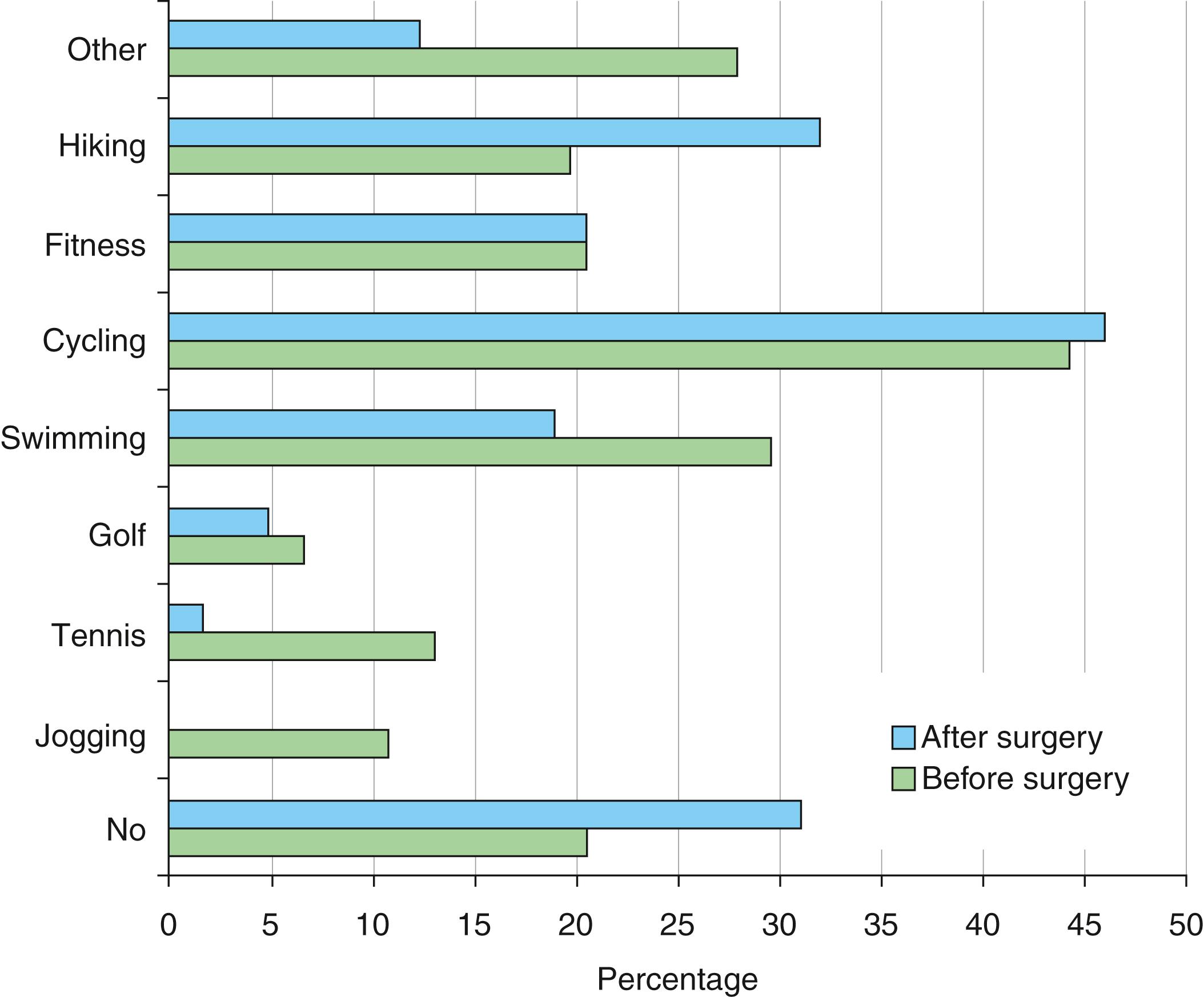
Assessment of medical comorbidities is important to prevent complications after surgery. In patients with diabetes, studies strongly suggest that good glycemic control, as manifested by a hemoglobin A1c level less than 7.0, should be obtained before major ankle or hindfoot reconstruction. Peripheral vascular disease should be identified and treated before surgery. Patients with a history of cardiac disease or pulmonary dysfunction also must have these conditions treated before surgery because of the increased functional demands in the immediate postoperative period as the patient mobilizes with crutches or a walker. Smoking tobacco directly interferes with the healing of the arthrodesis. In conjunction with a rheumatologist, patients with inflammatory arthritis should be taken off of antitumor necrosis factor-α medications preoperatively until the incisions are healed to decrease postoperative infection. Many patients have a vitamin D deficiency, and it is routine to supplement this pre- and postoperatively. Moderate-to-severe osteopenia found on plain radiographs should be investigated for a treatable cause before surgery. Patients in whom sleep apnea is suspected should be questioned about sleep habits, and this condition should be treated before surgery.
After a thorough history, assessment of the limb begins with evaluation of the patient’s gait pattern. Two common mechanisms of decreasing motion through the ankle joint are “back-kneeing” and walking with an elevated foot progression angle (turning the foot outward to decrease the lever arm on the ankle). In some patients who back-knee, applying a small heel lift may improve symptoms. Limb-length discrepancy may be obvious in the gait assessment and may affect the type of arthrodesis chosen. The range of motion of the hip and knee should be assessed, as well as deformity of the knee in the coronal plane. Although every attempt is made to place the ankle perpendicular to the long axis of the tibia and parallel to the ground, varus or valgus deformity of the knee may affect outcome and should be considered before surgery. Range of motion through the tibiotalar joint is difficult to assess, but an effort should be made to isolate this joint and separately evaluate the hindfoot joints. The talonavicular joint, which will be responsible for most sagittal plane motion after surgery, should carefully be inspected for range of motion and pain. Overall flexibility of the hindfoot is important. A stiff, immobile, and irritable hindfoot may be a source of continued problems after tibiotalar arthrodesis, and deformity of the hindfoot must be identified and considered in preoperative planning. Although a few degrees of malalignment can be compensated for through the ankle arthrodesis, significant deformity will need to be corrected with a separate procedure. A thorough neurovascular examination is critical because approaches to the ankle are often placed near cutaneous nerves and any deficits should be noted preoperatively. Any suggestion of diminished pulses or patients with long-standing diabetes should prompt an in-depth assessment with arterial Doppler ultrasound. Selective injections of a local anesthetic, with or without the aid of fluoroscopy, can be helpful in patients with combined arthritis of the ankle and hindfoot. We give our patients a visual analog scale, with values of 0 (no pain) to 10 (worst pain imaginable) and ask them to check a location on the scale before and just after the injection is given. Stegeman et al., however, found that fluoroscopically guided anesthetic injections were not indicative of a successful outcome of arthrodesis. Based on the effect of the diagnostic injection and various clinical factors, patients were treated conservatively or with arthrodesis. Arthrodesis, regardless of the presence or absence of pain reduction after injection, resulted in improvements in pain and function, whereas conservative treatment resulted in worse pain and function.
Become a Clinical Tree membership for Full access and enjoy Unlimited articles
If you are a member. Log in here